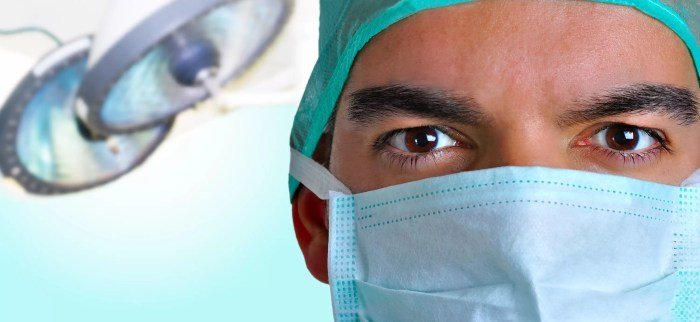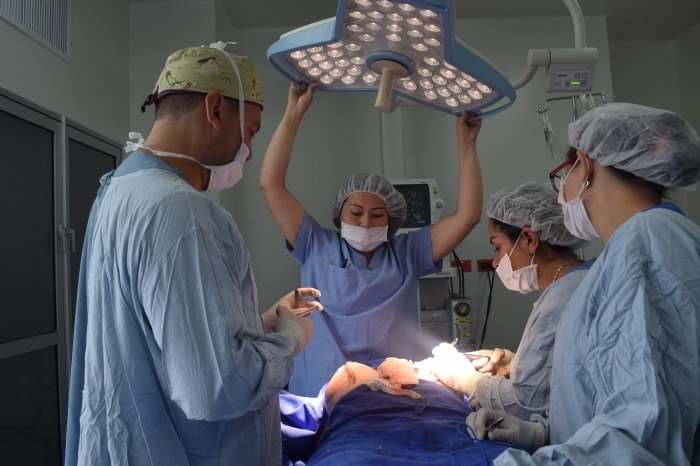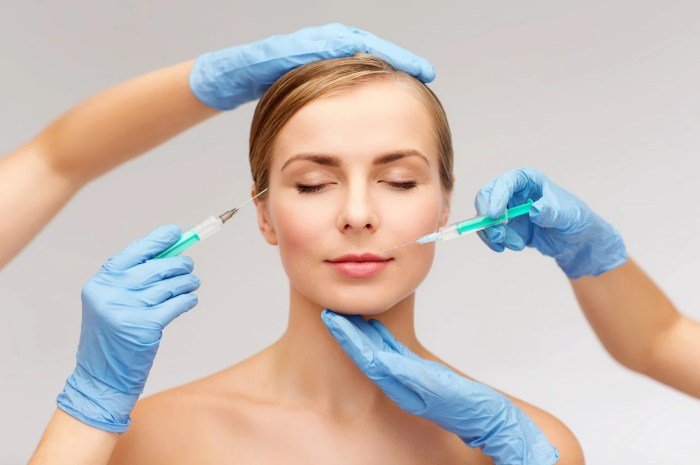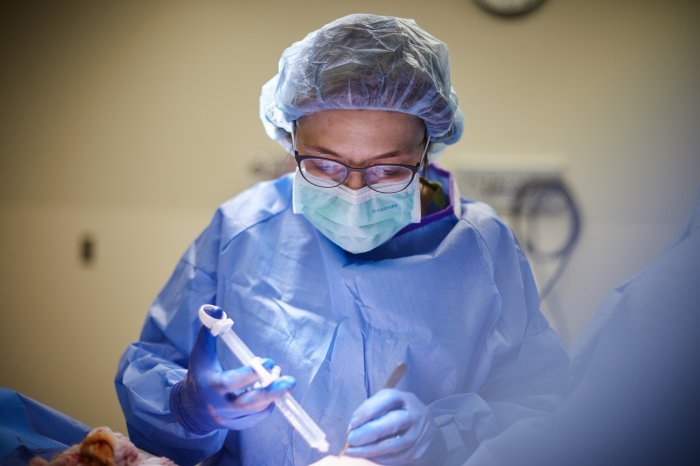Beauty surgeon, a term that evokes images of sculpted features and youthful appearances, holds a captivating allure in today’s society. It represents a desire for self-improvement and the pursuit of an idealized aesthetic. But beyond the glamour and the promise of enhanced beauty, lies a complex world of medical advancements, ethical considerations, and profound societal impacts.
This exploration delves into the history, procedures, and implications of beauty surgery, shedding light on its intricate journey through time and its enduring influence on individuals and society.
From the earliest documented cosmetic surgeries in ancient civilizations to the modern era’s sophisticated techniques, beauty surgery has evolved alongside changing cultural ideals and technological breakthroughs. We will examine the driving forces behind its increasing popularity, exploring the factors that motivate individuals to seek these procedures, as well as the ethical considerations that arise from the pursuit of enhanced beauty.
The Rise of Beauty Surgery

Beauty surgery, also known as cosmetic surgery, has witnessed a remarkable rise in popularity over the past few decades. This surge can be attributed to a confluence of factors, including societal pressures, advancements in technology, and a growing emphasis on personal appearance.
Historical Evolution of Beauty Surgery
The roots of beauty surgery can be traced back to ancient civilizations. Early examples include rhinoplasty, the surgical reshaping of the nose, which was practiced in ancient India and by the Egyptians. In the 19th century, the development of anesthesia and antisepsis paved the way for more sophisticated surgical procedures.
However, it was not until the latter half of the 20th century that beauty surgery truly began to gain widespread acceptance.
Factors Contributing to Increased Popularity
- Increased Media Exposure:The rise of social media and reality television has significantly contributed to the increasing visibility and normalization of beauty surgery. These platforms often showcase individuals who have undergone procedures, creating a culture where aesthetic enhancements are presented as desirable and attainable.
- Advancements in Technology:Technological advancements have led to less invasive procedures, faster recovery times, and more natural-looking results. For example, the development of lasers and fillers has revolutionized non-surgical procedures, making them more accessible and appealing to a wider audience.
- Growing Emphasis on Appearance:In many societies, there is a growing emphasis on physical appearance, particularly in fields such as entertainment, fashion, and business. This societal pressure can motivate individuals to seek out beauty surgery as a means of enhancing their appearance and achieving a competitive edge.
- Increased Accessibility:Beauty surgery has become more accessible to a broader population due to factors such as increased insurance coverage for certain procedures, the availability of financing options, and the proliferation of specialized clinics and surgeons.
Prominent Figures and Their Experiences
Several prominent figures have publicly discussed their experiences with beauty surgery, helping to further normalize the practice. For example, actress and television personality, [Prominent Figure 1 Name], has openly spoken about her decision to undergo a [Procedure 1] and [Procedure 2] to address her [Reason 1].
Similarly, [Prominent Figure 2 Name], a renowned [Occupation 2], has shared her experience with [Procedure 3] and how it has impacted her [Reason 2]. These public figures serve as examples of how beauty surgery can be a personal choice for individuals seeking to enhance their appearance and improve their self-confidence.
Types of Beauty Surgery Procedures

Beauty surgery, also known as cosmetic surgery, encompasses a wide range of procedures designed to enhance or alter physical appearance. These procedures are performed by qualified surgeons and are typically elective, meaning they are not medically necessary.
Common Beauty Surgery Procedures
The following table lists some of the most common beauty surgery procedures, their descriptions, common areas of application, and potential risks and complications:
| Procedure Name | Description | Common Areas of Application | Potential Risks and Complications |
|---|---|---|---|
| Rhinoplasty | Rhinoplasty, also known as a nose job, is a surgical procedure that reshapes the nose. It can address issues such as a crooked nose, a bulbous tip, or a large nasal bridge. | Nose | Bleeding, infection, asymmetry, breathing difficulties, and changes in the sense of smell. |
| Breast Augmentation | Breast augmentation involves inserting implants or fat grafting to increase breast size or change their shape. | Breasts | Capsular contracture, implant rupture, asymmetry, pain, and infection. |
| Liposuction | Liposuction is a procedure that removes excess fat from specific areas of the body. | Abdomen, thighs, hips, arms, and chin | Skin irregularities, fluid imbalances, infection, and nerve damage. |
| Facelift | A facelift, also known as a rhytidectomy, tightens the skin and underlying tissues of the face and neck to reduce the appearance of wrinkles and sagging. | Face and neck | Bleeding, infection, nerve damage, and asymmetry. |
Rhinoplasty
Rhinoplasty is a surgical procedure that reshapes the nose. It can address issues such as a crooked nose, a bulbous tip, or a large nasal bridge. The procedure involves making incisions inside the nose to access the underlying cartilage and bone.
The surgeon then reshapes the nose by removing, adding, or repositioning tissue. The recovery period for rhinoplasty typically involves some swelling and bruising, which can last for several weeks. It is important to follow the surgeon’s instructions carefully to minimize complications.
Breast Augmentation
Breast augmentation is a procedure that involves inserting implants or fat grafting to increase breast size or change their shape. The implants are typically made of silicone or saline and are placed either under the muscle or under the breast tissue.
Fat grafting involves transferring fat from another area of the body to the breasts.The recovery period for breast augmentation can vary depending on the technique used. It typically involves some pain, swelling, and bruising. It is important to wear a supportive bra for several weeks after surgery.
Liposuction
Liposuction is a procedure that removes excess fat from specific areas of the body. The procedure involves making small incisions in the skin and inserting a cannula, a thin tube with a suction tip, to remove the fat. The recovery period for liposuction typically involves some swelling, bruising, and discomfort.
It is important to wear compression garments for several weeks after surgery to help reduce swelling and promote healing.
Facelift
A facelift, also known as a rhytidectomy, tightens the skin and underlying tissues of the face and neck to reduce the appearance of wrinkles and sagging. The procedure involves making incisions in the hairline, around the ears, and under the chin.
The surgeon then lifts the skin and underlying tissues, removes excess skin, and sutures the incisions closed.The recovery period for a facelift can vary depending on the extent of the procedure. It typically involves some swelling, bruising, and discomfort. It is important to avoid strenuous activity for several weeks after surgery.
Ethical Considerations, Beauty surgeon
Beauty surgery raises ethical considerations, particularly concerning procedures such as breast augmentation and rhinoplasty. These procedures can be used to enhance natural features, but they can also be used to conform to societal beauty standards, which can be harmful and perpetuate unrealistic expectations.It is important for individuals considering beauty surgery to have realistic expectations and to understand the potential risks and complications.
They should also discuss their motivations with their surgeon and ensure that they are comfortable with the procedure and its potential outcomes.
Finding a Qualified Beauty Surgeon

Choosing the right beauty surgeon is a crucial decision that should not be taken lightly. Your safety and the outcome of your procedure depend heavily on the surgeon’s expertise and experience. It’s essential to understand the qualifications and certifications that make a surgeon qualified to perform beauty surgery procedures.
While a beauty surgeon can enhance your features, maintaining a healthy lifestyle is equally important. Finding a balance between surgical procedures and a fitness routine can be key to achieving your desired look. If you’re looking to incorporate swimming into your fitness plan, you might want to check out fitness centers with a pool near me.
Swimming is a great way to stay active and tone your muscles, which can complement the results of any surgical procedure.
Qualifications and Certifications
The qualifications and certifications of a beauty surgeon are crucial indicators of their training and expertise. A qualified surgeon will possess a medical degree, board certification, and specialized training in aesthetic surgery.
- Medical Degree:All surgeons must hold a medical degree (MD or DO) from an accredited medical school. This degree signifies that they have completed a rigorous curriculum in medical sciences and have passed licensing exams.
- Board Certification:Board certification in plastic surgery or a related specialty is essential. This certification indicates that the surgeon has completed a residency program in their chosen specialty and passed a rigorous exam demonstrating their knowledge and skills. The American Board of Plastic Surgery (ABPS) is a recognized board that certifies plastic surgeons in the United States.
While a beauty surgeon can enhance physical features, achieving a healthy and toned physique often requires a commitment to fitness. If you’re looking for guidance on a skinny fitness plan, there are numerous resources available online and in person.
Ultimately, a beauty surgeon can help with cosmetic enhancements, but a healthy lifestyle is essential for true inner and outer beauty.
Other recognized boards include the American Board of Facial Plastic and Reconstructive Surgery (ABFPRS) and the American Board of Otolaryngology-Head and Neck Surgery (ABOHNS) for surgeons specializing in facial surgery.
- Specialized Training:While board certification demonstrates a strong foundation in surgery, it’s crucial for a beauty surgeon to have additional training in aesthetic procedures. This can include fellowships, workshops, or advanced courses in specific areas of beauty surgery, such as facial rejuvenation, breast augmentation, or body contouring.
Selecting a Beauty Surgeon
When choosing a beauty surgeon, it’s important to consider several factors that contribute to a successful and safe outcome.
- Experience:Look for a surgeon with extensive experience performing the specific procedure you’re considering. Experience is crucial for developing expertise and refining surgical techniques. Consider asking about the surgeon’s case volume and their track record with the procedure.
- Board Certification:Ensure the surgeon is board certified by a recognized board in their specialty, such as the ABPS, ABFPRS, or ABOHNS. This certification demonstrates their expertise and commitment to upholding professional standards.
- Patient Reviews:Read patient reviews and testimonials to gain insights into the surgeon’s communication style, bedside manner, and patient satisfaction. Online platforms and medical websites often provide access to patient reviews. However, remember that individual experiences can vary, and it’s essential to consider the overall trend and the surgeon’s response to any negative reviews.
- Consultation Process:A thorough consultation is essential for discussing your goals, expectations, and any concerns. The surgeon should be attentive, answer your questions clearly, and provide a comprehensive explanation of the procedure, risks, and recovery process.
Scheduling a Consultation and Asking Relevant Questions
The consultation is your opportunity to meet the surgeon, discuss your goals, and ask any questions you may have.
- Scheduling the Consultation:Contact the surgeon’s office to schedule a consultation. Be prepared to provide your medical history, insurance information, and any relevant details about the procedure you’re interested in.
- Questions to Ask:During the consultation, ask the surgeon about their experience with the procedure, their approach to patient safety, and their communication style. You should also ask about the following:
- What are the risks and complications associated with the procedure?
- What is the recovery process like?
- What are the expected results?
- How will the procedure affect my appearance?
- What are the costs associated with the procedure?
- Do you offer financing options?
- What are your policies regarding follow-up appointments and consultations?
The Role of Technology in Beauty Surgery

Technology has revolutionized the field of beauty surgery, enhancing both the precision and safety of procedures while offering patients more personalized and natural-looking results. From advanced imaging techniques to minimally invasive procedures, technological advancements have transformed the way beauty surgery is performed and the outcomes achieved.
Computer Imaging and Simulation Software
Computer imaging and simulation software play a crucial role in pre-operative planning, allowing surgeons to visualize the potential outcome of a procedure before it is performed. These software programs enable surgeons to create a 3D model of the patient’s face or body, allowing them to simulate the effects of different surgical techniques and adjust the treatment plan accordingly.
This technology helps to ensure that the final result meets the patient’s expectations and minimizes the risk of complications.
“Computer imaging and simulation software are powerful tools that allow surgeons to personalize treatment plans and optimize outcomes. They are particularly beneficial for procedures like rhinoplasty, where subtle changes can significantly impact the final result.”
Emerging Technologies
Several emerging technologies are transforming the field of beauty surgery, offering new possibilities for enhancing precision, minimizing invasiveness, and improving patient outcomes.
- Minimally Invasive Techniques: These techniques, such as endoscopic surgery and laser treatments, allow surgeons to perform procedures with smaller incisions, resulting in less scarring, faster recovery times, and reduced pain. For example, endoscopic brow lifts utilize tiny incisions hidden within the hairline, allowing for a more natural and less noticeable approach.
- 3D Printing: 3D printing is being used to create customized implants and surgical guides, which can be tailored to the specific anatomy of each patient. This technology allows for greater accuracy and precision during surgery, leading to improved outcomes and reduced complications.
For example, 3D-printed guides can be used in rhinoplasty to ensure that the nasal implants are positioned correctly and symmetrically.
- Artificial Intelligence (AI): AI algorithms are being developed to assist surgeons in identifying the best treatment options and predicting potential complications. These algorithms can analyze vast amounts of data from patient records and medical images, helping surgeons make more informed decisions and personalize treatment plans.
AI is also being used to develop new surgical robots that can perform procedures with greater precision and accuracy.
The Psychological and Social Impact of Beauty Surgery
The decision to undergo beauty surgery is often driven by a complex interplay of psychological and social factors. Understanding these influences is crucial for both individuals considering surgery and healthcare professionals guiding them.
Psychological Factors Influencing Beauty Surgery Decisions
The decision to undergo beauty surgery is often influenced by a range of psychological factors. These factors can be broadly categorized into:
- Body Dissatisfaction and Self-Esteem:Many individuals seeking beauty surgery experience significant dissatisfaction with their appearance, leading to negative self-image and low self-esteem. They may perceive their physical features as flaws or imperfections, impacting their overall sense of well-being and confidence. For instance, someone with a prominent nose may feel self-conscious about their profile and seek rhinoplasty to improve their perceived appearance.
- Desire for Perfectionism and Idealized Beauty:Societal beauty standards often portray unrealistic ideals of physical perfection, influencing individuals’ perceptions of their own appearance. The constant exposure to idealized images in media, advertising, and social media can create a desire to conform to these unrealistic standards, leading some to seek beauty surgery as a means to achieve perceived perfection.
- Psychological Distress and Mental Health:Individuals struggling with body dysmorphic disorder (BDD), a mental health condition characterized by obsessive preoccupation with perceived flaws, may seek beauty surgery to alleviate their distress. However, surgery alone may not address the underlying psychological issues, and ongoing therapy may be necessary for long-term well-being.
- Social Comparison and Peer Pressure:Social comparison, particularly in the age of social media, can play a significant role in influencing individuals’ decisions regarding beauty surgery. Comparing oneself to others, often with idealized or edited images, can lead to feelings of inadequacy and a desire to conform to perceived social norms.
Benefits and Drawbacks of Beauty Surgery on Self-Esteem and Body Image
Beauty surgery can potentially impact self-esteem and body image in both positive and negative ways.
Potential Benefits
- Increased Self-Confidence:For some individuals, beauty surgery can lead to improved self-confidence and a more positive body image. This can be particularly beneficial for those struggling with body dissatisfaction and low self-esteem. For example, a person who has undergone breast augmentation may feel more comfortable in their own skin and experience an increased sense of femininity.
- Reduced Anxiety and Depression:In some cases, beauty surgery can alleviate anxiety and depression related to body image concerns. When individuals feel more comfortable with their appearance, it can lead to a reduction in negative thoughts and feelings associated with their perceived flaws.
- Improved Social Interactions:Increased self-confidence and a more positive body image can improve social interactions and lead to greater self-assurance in social settings.
Potential Drawbacks
- Unrealistic Expectations:It’s crucial to manage expectations regarding the outcomes of beauty surgery. While surgery can improve certain features, it may not completely eliminate body dissatisfaction or address underlying psychological issues. This can lead to disappointment and further distress if expectations are not met.
- Body Dysmorphic Disorder:In some cases, beauty surgery can exacerbate body dysmorphic disorder (BDD). This occurs when individuals become preoccupied with perceived flaws, even after undergoing surgery. They may focus on new perceived imperfections, leading to a cycle of dissatisfaction and further surgical interventions.
- Addiction to Surgery:Some individuals may develop an addiction to beauty surgery, seeking repeated procedures to achieve a perceived ideal. This can be financially and emotionally draining and may not necessarily lead to long-term satisfaction.
- Social Stigma:Individuals who have undergone beauty surgery may face social stigma or judgment. This can be particularly challenging for those who are not open about their procedures or who fear being perceived as vain or superficial.
Societal Pressures and Beauty Standards
The demand for beauty surgery is often fueled by societal pressures and beauty standards that are constantly evolving.
- Media and Advertising:The media and advertising industry play a significant role in shaping beauty standards by promoting unrealistic ideals of physical perfection. These images often portray airbrushed, digitally enhanced, or surgically altered bodies, creating an unattainable standard that can lead to body dissatisfaction and a desire to conform.
- Social Media:Social media platforms have amplified the impact of societal beauty standards, providing a constant stream of idealized images and promoting a culture of comparison. The pressure to maintain a perfect online persona can contribute to body dissatisfaction and a desire to seek beauty surgery to achieve a perceived ideal.
- Cultural Influences:Cultural influences also play a role in shaping beauty standards. Different cultures may have different ideals of beauty, influencing the types of beauty surgery procedures that are most sought after.
- Celebrities and Influencers:Celebrities and social media influencers often serve as role models, influencing beauty standards and promoting a culture of cosmetic enhancement. Their seemingly perfect appearances can create a desire for similar results, leading some individuals to seek beauty surgery.
Ethical Considerations in Beauty Surgery
The burgeoning field of beauty surgery presents a complex ethical landscape, demanding careful consideration of patient autonomy, informed consent, and the potential for objectification. This section explores these ethical dilemmas and the role of medical professionals in navigating them responsibly.
Patient Autonomy and Informed Consent
Informed consent is a cornerstone of ethical medical practice, ensuring patients understand the risks, benefits, and alternatives associated with a procedure before making a decision. In the context of beauty surgery, the pursuit of aesthetic ideals can sometimes overshadow a patient’s understanding of the potential complications and long-term consequences.
- Patients must be fully informed about the potential risks, benefits, and limitations of the procedure, including the possibility of complications, the need for multiple procedures, and the potential for dissatisfaction with the outcome.
- The surgeon should ensure that the patient’s motivations for seeking surgery are realistic and that they understand the limitations of surgery in achieving their desired outcome.
- Patients should be encouraged to ask questions and express their concerns, and the surgeon should be prepared to provide clear and comprehensive answers.
It is crucial to ensure that patients are making autonomous decisions, free from coercion or undue influence. This means that patients must be empowered to make choices based on their own values and priorities, not solely on societal pressures or the expectations of others.
Objectification and Body Image
Beauty surgery can raise concerns about objectification and the perpetuation of unrealistic beauty standards.
- The focus on physical appearance can reinforce the notion that outward beauty is paramount, potentially leading to a diminished emphasis on inner qualities and individual worth.
- The proliferation of images and media promoting idealized body types can create a culture of dissatisfaction and pressure to conform, which can contribute to body image issues and mental health challenges.
- Surgeons must be sensitive to the potential for objectification and strive to create a culture of respect and inclusivity in their practice.
It is essential for surgeons to engage in critical reflection about the potential impact of their work on patients’ self-esteem and body image.
Examples of Ethical Concerns in Beauty Surgery
Numerous cases have highlighted ethical concerns in beauty surgery.
- The “Snapchat Dysmorphia” Phenomenon:This refers to patients seeking surgery to achieve features they perceive as ideal based on filtered images they see on social media platforms. These filters often create unrealistic and unattainable standards of beauty, leading patients to pursue procedures that may not align with their natural features or their overall well-being.
- Surgeries Performed on Minors:The ethical considerations surrounding beauty surgery on minors are particularly complex. The decision to undergo such procedures should be made by the individual when they are mature enough to understand the implications and potential risks. In cases where minors seek surgery, it is essential to involve parents or guardians in the decision-making process, ensuring that the child’s best interests are paramount.
- Over-Surgery and “Plastic Surgery Addiction”:Some patients may become fixated on achieving a particular aesthetic, leading them to undergo multiple procedures that may not be medically necessary. Surgeons have a responsibility to identify and address this phenomenon, prioritizing patient well-being over the pursuit of unattainable beauty standards.
Future Trends in Beauty Surgery: Beauty Surgeon

The field of beauty surgery is constantly evolving, driven by technological advancements, shifting societal norms, and evolving patient preferences. As we look toward the future, several trends are likely to shape the landscape of beauty surgery, leading to more personalized, minimally invasive, and technologically advanced procedures.
Personalized Medicine and Genetic Testing
Personalized medicine is revolutionizing healthcare by tailoring treatments to individual patients’ genetic makeup. In beauty surgery, this approach is expected to play a significant role in customizing procedures for optimal results.
- Genetic Testing for Skin Health:Genetic testing can identify predispositions to skin conditions like wrinkles, sun damage, and premature aging. This information can help surgeons develop personalized treatment plans, including preventative measures and targeted therapies.
- Predicting Treatment Outcomes:Genetic testing can also predict how patients will respond to specific treatments, allowing surgeons to choose the most effective procedures and minimize risks. For example, testing can reveal an individual’s susceptibility to scarring, guiding surgeons towards minimally invasive techniques.
- Personalized Products and Treatments:Personalized medicine will drive the development of customized skincare products and treatments based on individual genetic profiles. This will lead to more targeted and effective solutions for specific skin concerns.
Advancements in Technology
Technological advancements are continuously transforming beauty surgery, making procedures safer, more effective, and less invasive.
Beauty surgeons are often at the forefront of medical advancements, constantly seeking to refine techniques and improve patient outcomes. Their work often intersects with the broader world of healthcare, particularly in areas like safety and ethical considerations, as exemplified by the work of organizations like the World Health Organization.
This intersection highlights the importance of a holistic approach to beauty surgery, ensuring that it aligns with broader health and safety standards.
- Artificial Intelligence (AI):AI is being used to analyze patient data, predict outcomes, and personalize treatment plans. AI-powered tools can assist surgeons in planning procedures, optimizing results, and minimizing complications.
- Robotics:Robotic surgery is gaining traction in beauty surgery, offering greater precision and control. Robotic arms can perform delicate procedures with minimal scarring, leading to faster recovery times and improved outcomes.
- Virtual Reality (VR):VR technology is being used to create realistic simulations of surgical procedures, allowing surgeons to practice and refine their techniques before operating on patients. VR can also help patients visualize the potential results of a procedure before making a decision.
- 3D Printing:3D printing is being used to create personalized implants and prosthetics for facial reconstruction and other procedures. 3D-printed implants can be tailored to a patient’s unique anatomy, ensuring a more natural and aesthetically pleasing outcome.
Non-Surgical and Minimally Invasive Procedures
As patients seek less invasive and quicker recovery options, non-surgical and minimally invasive procedures are becoming increasingly popular.
- Injectable Fillers and Neurotoxins:Injectable fillers and neurotoxins like Botox continue to be popular choices for wrinkle reduction, facial contouring, and lip augmentation. Advancements in these products are leading to longer-lasting effects and more natural-looking results.
- Laser Treatments:Laser treatments are used for various aesthetic concerns, including skin rejuvenation, hair removal, and tattoo removal. Advancements in laser technology are leading to more precise and effective treatments with minimal downtime.
- Radiofrequency Devices:Radiofrequency devices use heat to tighten skin and reduce wrinkles. These devices are becoming increasingly sophisticated, offering customizable treatments for different skin types and concerns.
- Platelet-Rich Plasma (PRP):PRP is a natural treatment that uses a patient’s own blood platelets to stimulate collagen production and promote tissue regeneration. PRP is used for skin rejuvenation, hair loss treatment, and wound healing.
Ethical Considerations, Beauty surgeon
As beauty surgery becomes more accessible and technologically advanced, it is crucial to address ethical considerations.
- Patient Safety and Informed Consent:It is essential to ensure patient safety and obtain informed consent before any procedure. Patients should be fully informed about the risks, benefits, and potential complications of any treatment.
- Body Image and Societal Pressures:Beauty surgery can be influenced by societal pressures and unrealistic beauty standards. It is important to promote a healthy body image and discourage the pursuit of unattainable ideals.
- Access and Equity:Ensuring equitable access to quality beauty surgery is essential. This includes addressing affordability concerns and providing culturally sensitive care.
- Regulation and Oversight:Clear regulations and oversight are necessary to ensure ethical practices and protect patients from unqualified surgeons and unsafe procedures.
Conclusion
The world of beauty surgery is a fascinating blend of science, art, and societal pressures. As technology continues to advance and societal norms evolve, the future of beauty surgery promises both exciting possibilities and ethical challenges. By understanding the history, procedures, and implications of this field, we can navigate the complex landscape of beauty enhancement with greater awareness and informed decision-making.
Essential Questionnaire
Is beauty surgery safe?
Like any surgical procedure, beauty surgery carries risks and potential complications. The safety of a procedure depends on factors such as the surgeon’s qualifications, the individual’s health, and the specific procedure performed. It’s crucial to consult with a qualified and experienced surgeon and discuss the potential risks and benefits thoroughly.
How much does beauty surgery cost?
The cost of beauty surgery varies significantly depending on the type of procedure, the surgeon’s fees, and the location. It’s recommended to obtain detailed cost estimates from multiple surgeons before making a decision.
Is beauty surgery covered by insurance?
In most cases, beauty surgery is considered elective and is not covered by health insurance. However, some procedures, such as reconstructive surgery after an accident or injury, may be covered. It’s essential to check with your insurance provider for specific coverage details.